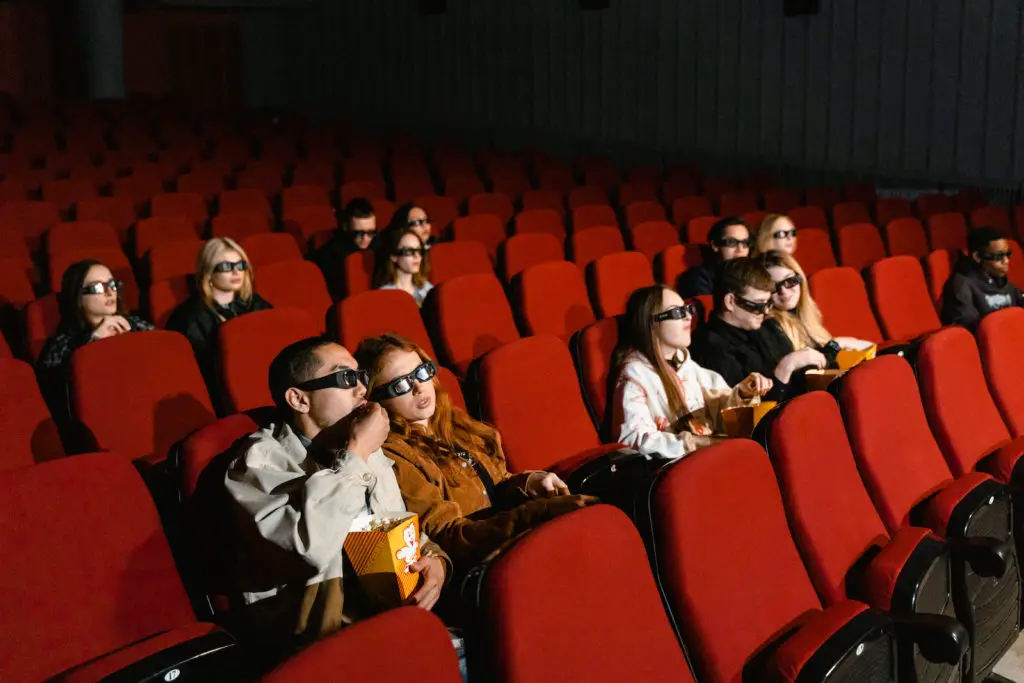
They don’t have cherry blossoms in Japantown anymore (well, not many, anyway), but there is a marker for spring here in San Francisco that’s just as beautiful and contemplative. Each March, the San Francisco International Asian Film Festival takes over a wing of the Kabuki Theater, and by now, it seems like an old friend.
Haven’t been? For you travelers who like to take spring vacations early, nothing beats a stroll through the mall next door, filled with all things Japanese – a bookstore, video store and several restaurants, followed by a walk up Fillmore Street and into Pacific Heights, followed by a relaxing evening of films from all over Asia, and all around America. Alcatraz can wait a day or two; it’ll still be there.
The nation’s largest and oldest Asian festival turns 21 this year, and there isn’t a better metaphor for the 131-film event – running March 6-16 — than the young people of Georgia Lee’s 11-minute short “Educated,” who struggle to unleash themselves (literally) from their parents’ expectations. Breaking free from familial bonds and/or changing your worldview in the face of new global economies is a consistent theme this year, from the soccer-obsessed girl who just wants to Bend it Like Beckham in Gurinder Chadha’s opening night film to the middle-class adults who aren’t quite sure if technology serves them or they serve technology in Greg Pak’s closing night feature Robot Stories.
The tent pole for this year’s festival, curated by festival director Chi-hui Yang and his team, is a focus on ethnic Indian cinema. Bend It Like Beckham comes from Chadha’s home base in the U.K., but Bollywood and its usual three-hour running times are represented with two blockbusters: Karan Johar’s 1998 melodramatic phenomenon “Kuch Kuch Hota Hai” and a blast from the past, the influential 1957 epic Mother India, with the British Film Institute providing a crisp, clean print of what is arguably India’s best known film, at least internationally.
There’s even a Canadian documentary, “Bollywood Bound,” which details the struggles of three Canadian-born Indians who are trying to make it on the Bombay big screen. But perhaps the hippest of the Indian Diaspora at this fest may be the world premiere of something really out of left field, or actually, Houston. “Where’s the Party Yaar?” is a modern culture-clash comedy that seems positively shagadelic at times.
Spring may be associated with youth, but renewal is also a theme, and several established masters, from the Philippines’ Marilou Diaz-Abaya (the politically charged “New Moon”) to local documentarian Spencer Nakasako (“Refugee,” another in his series of excellent personal immigrant stories) are back with new work. Heck, even such pantheon directors as Wong Kar-Wai (the music video “Six Days”) and Tsai Ming-Ling (“The Skywalk is Gone,” a 23-minute short starring, you guessed it, Lee Kang-Sheng) have gone back to their student days of making short films.
A few highlights from the SFIAFF, which is presented by the National Asian American Telecommunications Association:
“Eliana, Eliana” (Riri Riza, Indonesia 2002): A somber night out in a Jakarta taxi, with a mother and her runaway daughter (Rachel Maryam Sayidina), the movie was shot on DV but blown up to a compelling widescreen format. Riza’s straightforward economical style, expertly edited and relying on actors’ faces and a sprawling, photogenic city, is the stuff of big-time cinema, even if the scale is small. “Eliana, Eliana,” making its U.S. debut, hopefully will branch out to other festivals.
“Charlotte Sometimes” (Eric Byler, USA 2002): Wildly praised at the Hawaii International Film Festival and publicized by an admiring article by Roger Ebert, “Charlotte Sometimes” is indeed an extremely mature film that could stand as a textbook for low-budget DV filmmaking. A tale of two couples, starring some beautiful and charismatic acting talent (Michael Idemoto, Jacqueline Kim, Eugenia Yuan, Matt Westmore), it is confident and smooth, unafraid to take its time and reveal character slowly. However, I found the monotone, sometimes even wordless approach to Idemoto’s character to be a distraction – I mean, would two such hot babes be swooning over a guy who will barely talk to them, let alone show much interest? But overall, a very strong piece of work.
“Long Life, Happiness and Prosperity” (Mina Shum, Canada, 2002): Anyone who remembers Shum’s directorial debut, “Double Happiness” (1994) will be happy to know that her second feature is just as amusingly charming. Sandra Oh, who starred in “Double Happiness,” plays a single mom whose daughter (12-year-old Valerie Tian) tries Taoist magic to fix the broken-down lives of the people around her. It’s packed with a cast of familiar faces (including Tsai Chin of “The Joy Luck Club,” and veteran Ric Young, who has played villains in Indiana Jones and the Temple Doom” and “The Corruptor,” who gets to play a sweet role for once).
“No One’s Ark” (Nobuhiro Yamashita, Japan, 2002): Yamashita’s wicked sense of humor tackles the new economy, as misfit lovers (Hiroshi Yamamoto, Tomoko Kotera) turn entrepreneurs after inventing an energy drink that is, on the plus side, very nutritional, and on the minus side, putrid tasting. A truly oddball work, and deliciously so.
“The Game of Their Lives” (Daniel Gordon, United Kingdom, 2002): Add this to the list of great recent sports documentaries, as Gordon and his crew gained unprecedented access to North Korea to revisit members of the team that authored the greatest upset in World Cup soccer history. In 1966, an unheralded bunch from North Korea knocked out world powerhouse Italy 1-0, becoming the first Asian team to advance to the quarterfinals of the World Cup. Gordon weaves never-before-seen crisp color documentary footage and interviews with the North Koreans, the Italians and many of the fans of the small English city that adopted them, Middlesbrough, to create a portrait of a time and clashing ideologies.
“Neither Fish, Nor Fowl” (Matthias Keilich, Germany, 2002): Shot on grainy Super-16, this film would be valuable even if it wasn’t very good because of its depiction of growing up Asian in Europe, not often seen in these parts. As a bonus, it’s quite good, telling the story of a Korean-born German who only speaks German, as he was adopted as an infant by his white parents, and his exposure to his Korean heritage through his wooing of a girl in Berlin’s Koreatown.
“Unknown Pleasures” (Jia Zhang-Ke, China, 2002): A disclaimer – I didn’t like this movie, and I saw it twice just to make sure. But this follow-up to the director’s influential hit “Platform” has many critical admirers, and created good buzz at January’s Rotterdam International Film Festival. Jia is no doubt becoming one of Asia’s brightest lights, and his depiction of an emerging lost generation of China’s youth has much to say about the erosion of ideals and the rise of capitalism there.
“YMCA Baseball Team” (Kim Hyun-seok, South Korea, 2002): A thoroughly winning, corny movie about Korea’s first baseball team, the 1905 YMCA team trained by American missionaries and notably challenged by a team fielded by invading Japanese forces. Not much brilliant or cutting edge filmmaking, but there’s nothing wrong with a syrupy movie that invokes the same kind of inspiration of “Hoosiers” or “The Rookie.” You’ll laugh, you’ll cheer, you’ll cry, you’ll spill popcorn….
) And finally, a passing nod must be made to the new Thai cinema, fast gaining in importance at world festivals and represented here by “Mekhong Full Moon Party” and “I-San Special.” Both films take place in the I-San region, which is in northeastern Thailand near Laos, a mostly rural area. Jira Maligool’s “Mekhong” is an entertaining look at superstition vs. science centering around an annual phenomenon of mysterious balls of light that shoot up from the Mekhong River. “I-San Special,” making its U.S. premiere, is unique in concept. Mingmongkol Sanokul, a graduate of the San Francisco Art Institute, sets his first film on an all-night bus trip. During the tedious ride, the passengers begin to daydream and fancy themselves starring in a Thai soap opera. The soundtrack is actually lifted from a Thai soap opera, dubbing over the voices of the passengers. Experimental narrative cinema is always welcome – and what are festivals for but something new and different? – but the initially amusing idea quickly motors on beyond its usefulness; it’s one long ride to nowhere.
The festival also features a spotlight on Bay Area filmmaker and sound recordist Curtis Choy.
For more information, visit the SFIAAFF website.

